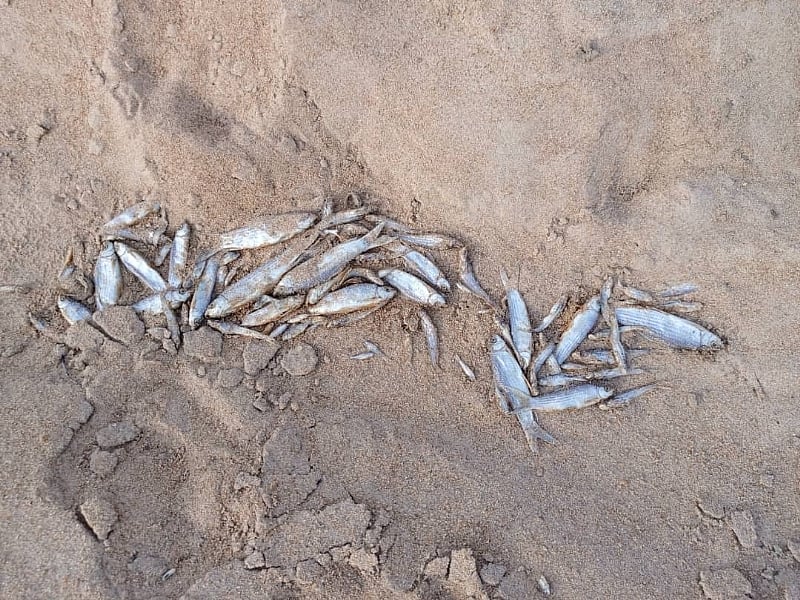The Fumbisi-Weisi stream in the Builsa South District of Ghana’s Upper East Region has become a scene of environmental concern and potential health risk as a large number of fish, including fingerlings, have been found dead. The disturbing discovery has sent shockwaves through the local community, prompting investigations and urgent public health warnings against consuming fish from the affected waterway. The Ghana News Agency (GNA) visited the site and reported a grim picture: dead fish of various species, including tilapia and catfish, floating in the darkened, foul-smelling water. Despite the presence of dead fish and the alarming change in the water’s appearance, some children were observed swimming in the stream, highlighting the need for rapid and effective community education.
Although no mining activity was observed by the GNA during their visit, residents suspect that chemical runoff from illegal mining operations in the area is the likely cause of the mass fish mortality. This suspicion underscores the ongoing challenges posed by illegal mining activities, which often lead to environmental degradation and health hazards. The incident highlights the urgent need for stricter enforcement of environmental regulations and intensified efforts to combat illegal mining practices. The potential consequences of such pollution extend beyond immediate environmental damage, posing a significant threat to human health through contaminated water sources and food chains.
The Builsa South District Director of the Ghana Health Service (GHS), Mr. Emmanuel Kuu-Ere Kob-Puo, confirmed the reports of dead fish and assured the public that investigations were underway. The GHS dispatched officers to the site to verify the reports and immediately initiated community education programs to warn residents against consuming fish from the contaminated stream. This swift action is crucial to prevent potential health issues arising from the consumption of contaminated fish. The GHS is also working closely with other stakeholders, including the Food and Drugs Authority (FDA), to gather samples and conduct a thorough investigation to determine the definitive cause of the fish kill.
Mr. Kob-Puo emphasized the importance of avoiding consumption of fish from the Fumbisi-Weisi stream, stressing the potential health risks associated with ingesting contaminated fish. He cautioned that consuming the fish could lead to various health complications, including food poisoning. While no cases of illness related to the consumption of the affected fish had been reported at the time of the initial report, the GHS has proactively alerted all health facilities in the area to be vigilant and watch for any individuals presenting with symptoms of food poisoning or abdominal pain. This proactive approach is essential to ensure that any potential health issues are identified and addressed promptly.
The District Chief Executive, accompanied by officials from the FDA and other relevant organizations, visited the site to collect samples and conduct further assessments. This collaborative effort demonstrates the seriousness with which the authorities are treating the situation. The investigation will focus on determining the source of the contamination and identifying the specific substances responsible for the fish kill. The findings of the investigation will be crucial in informing future preventative measures and addressing the underlying causes of the environmental incident. The public will be briefed on the outcome of the investigation once it is concluded.
The incident has understandably caused concern among residents, and one resident, Ms. Evelyn Salifu, shared her experience with the GNA. She recounted that the fish kill occurred on Thursday, April 17, 2025, expressing surprise at the unprecedented event. Ms. Salifu admitted that some residents, including herself, had collected and consumed some of the dead fish on the first day, assuming that thorough cooking would neutralize any potential toxins. However, the increasingly pungent odor and the disturbing change in the water’s color on subsequent days deterred further collection and consumption of the dead fish. This anecdote underscores the need for continued public education on the risks associated with consuming potentially contaminated food, even after cooking. The incident highlights the importance of proactive communication and community engagement to mitigate potential health risks in such situations. The swift response from the GHS and other relevant authorities demonstrates a commitment to safeguarding public health and protecting the environment. The ongoing investigation and continued public awareness campaigns are crucial steps in addressing the immediate concerns and implementing long-term preventative measures.


